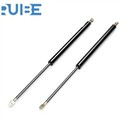Gas spring is an industrial accessory that can function as support, buffer, braking, height adjustment and angle adjustment. It consists of the following parts: pressure cylinder, piston rod, piston, sealing guide sleeve, filler (inert gas or oil-air mixture), in-cylinder control elements and out-of-cylinder control elements (referring to controllable gas springs) and joints.
The working principle is to fill the closed pressure cylinder with inert gas or oil and gas mixture, so that the pressure in the cavity is several times or dozens of times higher than the atmospheric pressure, and the pressure generated by using the cross-sectional area of the piston rod is smaller than that of the piston. difference to achieve the movement of the piston rod. Due to the fundamental difference in principle, gas springs have significant advantages over ordinary springs: relatively slow speed, little change in dynamic force (generally within 1:1.2), and easy control; the disadvantage is that the relative volume is not as small as the coil spring, and the cost is high , The lifespan is relatively short.
According to its characteristics and application fields, gas springs are also called support rods, angle adjusters, gas pressure rods, dampers, etc. According to the structure and function of the gas spring, there are several types of gas springs, such as free-type gas springs, self-locking gas springs, traction gas springs, random stop gas springs, swivel chair gas springs, gas pressure rods, and dampers. At present, the product is widely used in automobile, aviation, medical equipment, furniture, machinery manufacturing and other fields.






